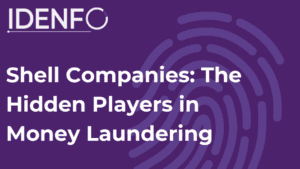The global fight against financial crime faces a persistent adversary in the form of shell companies—legal entities that serve as chameleons in the shadow economy. These corporate structures, while legitimate in certain contexts, have become indispensable tools for money launderers operating across the 3 stages of money laundering. This analysis examines how shell companies facilitate each phase of illicit financial flows and explores innovative solutions to combat their misuse in the Middle East and North Africa region.
The Three Stages of Money Laundering: A Framework for Concealment
To understand shell companies' strategic value, one must first contextualize their role within the money laundering stages:
Stage 1: Placement – Introducing Dirty Money
The initial phase involves injecting illicit funds into the financial system through methods like:
- Structured cash deposits below reporting thresholds
- Purchases of monetary instruments
- Commingling with legitimate business revenues
Shell companies begin their involvement here by providing seemingly valid reasons for large cash inflows, such as fictitious consulting fees or product sales.
Stage 2: Layering – The Obfuscation Engine
This critical phase sees shell companies reach peak utility. Criminals execute complex transactional networks involving:
- Cross-border wire transfers between multiple shell entities
- False invoicing for non-existent goods/services
- Asset conversions through cascading corporate structures
Stage 3: Integration – Legitimizing Clean Funds
In the final phase, laundered money re-enters the economy through:
- Real estate acquisitions via offshore holding companies
- Business investments through layered ownership structures
- Stock market transactions using nominee shareholders
Anatomy of a Shell Company: Features and Vulnerabilities
Shell companies possess distinct characteristics that make them ideal money laundering vehicles:
Structural Hallmarks
- No physical offices or operational assets
- Nominee directors shielding beneficial owners
- Registration in jurisdictions with strict privacy laws
Functional Mechanisms
- Acting as transactional intermediaries to break audit trails
- Generating false invoices to justify fund movements
- Holding accounts at multiple financial institutions
The 2016 Panama Papers leak revealed how over 200,000 shell entities facilitated $2 billion in illicit flows, including cases involving Middle Eastern political figures.
Layering in Action: Shell Company Techniques
Geographic Arbitrage
Money launderers exploit regulatory disparities by:
- Incorporating entities in secrecy jurisdictions (e.g., British Virgin Islands)
- Routing funds through medium-compliance nations
- Final integration in major financial hubs
This “triple-jump” method complicates investigative efforts across legal systems.
Transactional Obfuscation
A typical layering sequence might involve:
- Transferring funds from Drug Cartel LLC (Mexico) to Import-Export Ltd (Cyprus)
- Converting currency through Trading Co. (UAE)
- Purchasing cryptocurrency via Tech Solutions Inc. (Singapore)
Each shell entity adds layers of separation from the original crime.
Detection Challenges in MENA Markets
Financial institutions face multilayered obstacles:
Jurisdictional Complexity
- Varying corporate registry requirements across GCC states
- Inconsistent UBO disclosure rules in North African nations
Operational Barriers
- Limited access to cross-border ownership databases
- Manual verification processes for foreign corporate documents
Technological Gaps
- Legacy systems unable to map complex transaction chains
- Inadequate AI capabilities for pattern recognition
A 2024 MENA Financial Compliance Survey found that 67% of banks struggle to verify ultimate beneficiaries in multi-jurisdiction shell networks.
Combating Shell Company Abuse: IDENFO MENA's Compliance Framework
Modern AML solutions require layered defenses against shell company risks:
Advanced Due Diligence Protocols
- Biometric Verification: Facial recognition checks against forged corporate documents
- Blockchain Analysis: Tracing cryptocurrency flows through shell wallet addresses
- Dynamic Risk Scoring: Adjusting risk ratings based on network connections
Regulatory Technology Integration
- Automated PEP/sanctions screening across 200+ global watchlists
- Real-time monitoring of corporate structure changes
- AI-powered invoice validation against trade databases
Collaborative Compliance
- Shared typology databases with regional FIU partners
- Cross-institution alert systems for shell company red flags
The Future of Shell Company Detection
Emerging technologies promise paradigm shifts:
Predictive Analytics
Machine learning models that:
- Forecast potential shell company creation patterns
- Identify jurisdiction combinations favored by launderers
Quantum Computing
Processing power capable of:
- Mapping trillion-node transactional networks
- Breaking encrypted ownership structures
Decentralized Identity Systems
Blockchain-based registries providing:
- Immutable UBO records
- Real-time global access to corporate hierarchies
Conclusion: Closing the Shell Game
The battle against shell company-enabled money laundering demands constant innovation. By understanding their role across the 3 stages of money laundering, financial institutions can deploy targeted countermeasures. IDENFO MENA's end-to-end compliance platform delivers critical capabilities for:
- Automated document verification for corporate clients
- Continuous monitoring of complex transaction chains
- Instant alerts on beneficial ownership changes
As regulatory pressures intensify across MENA markets, solutions combining advanced technology with deep regional expertise will prove essential in dismantling the shell company infrastructure that sustains financial crime. The path forward lies not just in detecting existing schemes, but in anticipating and preventing their formation through predictive compliance strategies.









